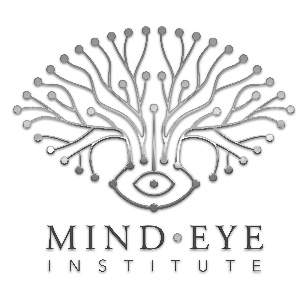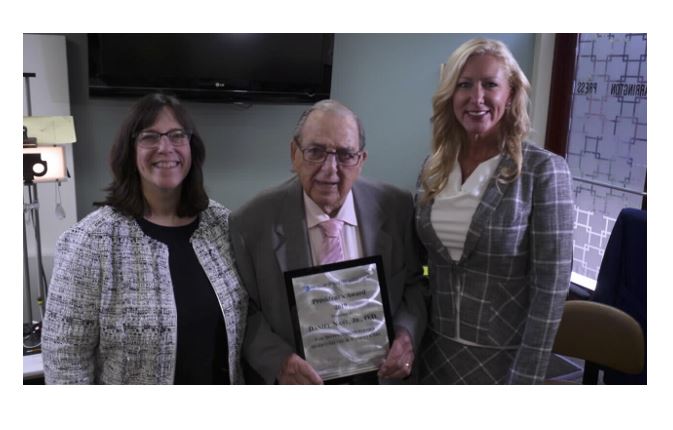
100-Year-Old Optometrist Still Sees Patients; Earns National Award
‘It’s Not Work When You Love What You Do’
Daniel Nast Jr., O.D., a 100-year-old optometrist who continues seeing patients at the Mind-Eye Institute in Northbrook, Ill., proudly holds the President’s Award, which was presented to him by the American Optometric Association (AOA) for his more than 77 years of distinguished service to optometry. He is flanked by Barbara Horn O.D. (right), president of the AOA, and Deborah Zelinsky O.D. (left), founder and research director of the Mind-Eye Institute. Dr. Horn says the AOA President’s Award is given to only a limited number of optometrists for exemplary service to their profession. Dr. Nast has been an AOA member for 65 years.

He may have turned 100 years old earlier this year, but optometrist Daniel Nast Jr., O.D., of the Mind-Eye Institute in Northbrook, Ill., continues doing what he has done for more than 77 years – caring for patients.
And, that is exactly why the American Optometric Association (AOA) has presented him with its President’s Award.
“The award is given to very few professionals. It is reserved only for those optometrists who have made extraordinary accomplishments in the field and who have been inspiring to others,” says AOA President Barbara Horn, O.D. “Dr. Nast has been all that. We are so proud and honored to be a part of his life.” In fact, Dr. Nast has been a member of the Illinois Optometric Association, a branch of the American Optometric Association, for more than 65 years.
Dr. Nast says some of his colleagues think “I’m crazy” for continuing to work at my age, but he quickly adds that “I enjoy helping people. I get a certain satisfaction from being able to help people read who could not read before and to comprehend what they could not comprehend before.
“I also am inquisitive by nature; I want to know ‘what’s new,’” says Dr. Nast, who reads the latest research articles and sees patients twice weekly at the Mind-Eye Institute, where he practices neuro-optometric rehabilitation.
A World War II veteran and a 1942 graduate of the Monroe College of Optometry, forerunner of the Illinois College of Optometry, Dr. Nast provided optometric services in his wartime role. “In those days, we tested soldiers’ eyesight using only a portable frame and loose lenses,” Dr. Nast says. For a brief time, he was stationed at Los Alamos, New Mexico where scientists there were secretly developing the first atomic bomb.
“We played cards in the evening, because there was nothing else to do, and we couldn’t leave the base,” Dr. Nast recalls.
After the war, Dr. Nast began his optometric career in earnest – a career that predates the invention of soft contact lenses -- eventually opening a private practice in Melrose Park, Ill. He remained there until he sold the practice 50 years later. “Someone came in one day and says, ‘I want to buy your practice,’” Dr. Nast remembers. “I said, ‘Make me an offer.’ He did, and that was that.”
Even after “retiring” from private practice, Dr. Nast continued working in various Chicago area optometric offices, offering an extra pair of professional hands when needed. At age 95, he found his way to the Mind-Eye Institute, where he was quickly hired by Institute founder and research director, Deborah Zelinsky, O.D., who knew him personally and long respected his work.
“Dr. Nast has been at the cutting-edge of optometry for most of his career,” says Dr. Zelinsky, adding that some people originally had questioned why she was putting such an elderly professional on her team. “He is a great asset. I was not hiring a 95-year-old body; I was hiring a brain with more than 70 years of optometric experience,” she says.
The Mind-Eye Institute, which emphasizes neuro-optometric rehabilitation, is internationally known for revolutionizing scientific understanding of retinal processing and its impact on brain function.
“We use many different types of optometric tools to readjust a patient’s balance, visual processing and eye-ear integration,” Dr. Zelinsky explains. “Changes in luminance on the eye affect how the brain interprets and reacts to information about the environment and can impact a person’s spatial awareness, body posture and selective attention to sound. Our BrainwearTM glasses are designed for comfort and efficiency of sensory processing, not simply eyesight.”
Much of the Institute’s focus is on assisting patients in recovery from traumatic brain injury, stroke or symptoms from post-traumatic vision syndrome. A percentage of Institute patients have learning problems and require a more solid connection between their eyes and ears to develop needed visual skills.
In presenting the AOA award to Dr. Nast, Dr. Horn of the AOA remarked that she, too, had questioned Dr. Nast about why he still wants to keep working as an optometrist. “He told me ‘it’s not work when you love what you do,’” Dr. Horn said.
As for Dr. Nast’s retirement plans, “not happening,” he says.
Editor’s Note: Daniel Nast Jr., O.D., resides in Northbrook, IL.
Contacts